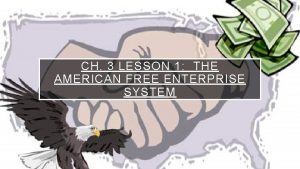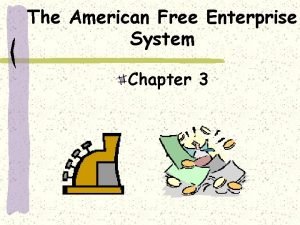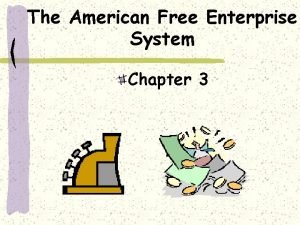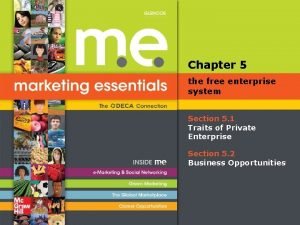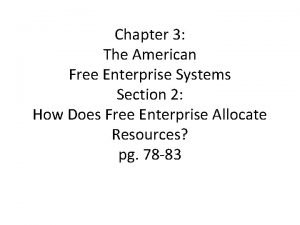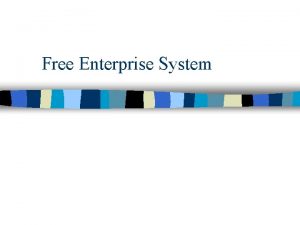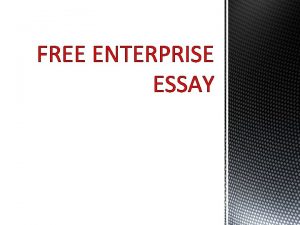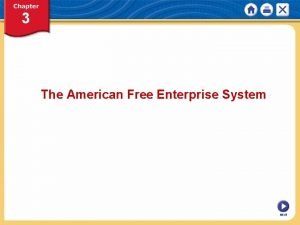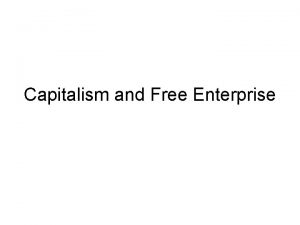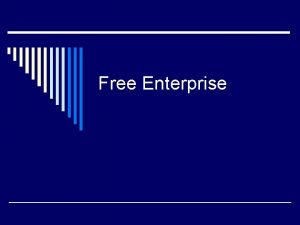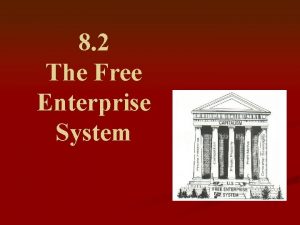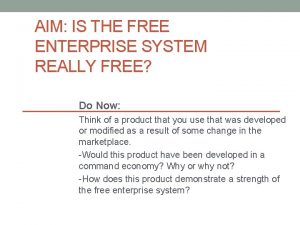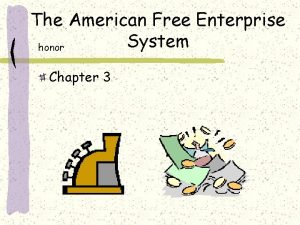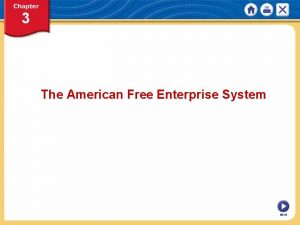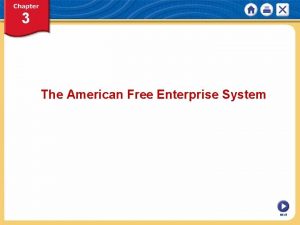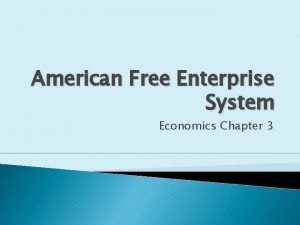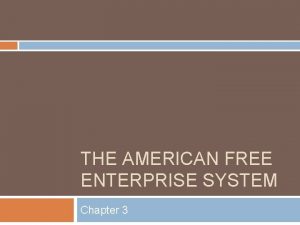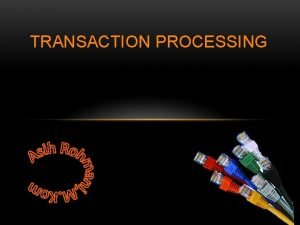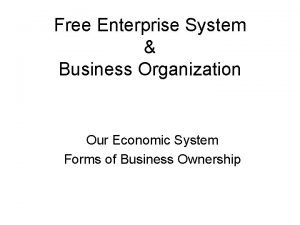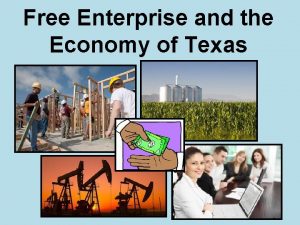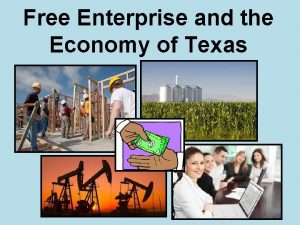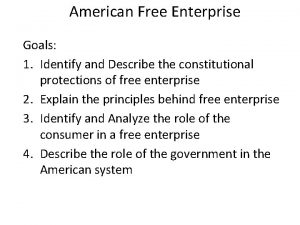The American Free Enterprise System Free Enterprise and
































- Slides: 32

The American Free Enterprise System


Free Enterprise and the Constitution The 5 th Amendment: “No person shall be deprived of life, liberty, or property without due process of law: nor shall private property be taken for public use without just compensation. ” Article 1, Section 10: “No state shall … pass any … law impairing the obligation of contracts”.

Free Enterprise and the Constitution, continued… Article 1, Section 8: “The Congress shall have power to lay and collect taxes, duties, imposts and excises, to pay the debts and provide for the common defense and general welfare of the United States…” The 16 th Amendment: Empowers Congress to tax "incomes, from whatever source derived, without apportionment among the several States, and without regard to any census or enumeration. "

The Constitution itself promotes innovation by the establishment of patents, copyrights, and trademarks. Article 1 Section 8: Congress has the power to “promote the progress of science and useful arts, by securing for limited times to authors and inventors the exclusive right to their writings and discoveries.

Basic Principles of Free Enterprise Profit Motive Business owners decide how to run their businesses. They will want to make decisions which maximize profits, so acting responsibly while also being innovative. Open Opportunity Concept that everyone can compete in the marketplacethere is “mobility” up or down depending on the success of your business Economic Rights of… 1 -Legal equality- everyone has the same rights 2 -Private property- you decide what to do with your property 3 -Free contract- you decide what agreements you want to enter into. 4 -Voluntary exchange- you decide what and when you want to sell These rights promote competition, the rivalry among sellers to attract customers

The Role of Government Constitution requires government to protect property rights, contracts, and other business activities. Though not explicitly stated, many Americans expect protection from such things as pollution and unsafe foods. Government has an important role to play in making sure consumers are provided with correct information from producers. It serves to protect consumers from dangerous products and services, and to stop businesses from making fraudulent claims. Public disclosure laws require companies to provide consumers important information about their products. Starting in the 1960’s, the government has played a much larger role in protecting the health, safety, and welfare of the public through regulations affect such industries as automobile manufacturing and pharmaceuticals. These consumer protection also include requiring labels on consumer packaging that provide important information There has been push-back by corporations that claim regulations are costly to implement, cut into profits, slow economic growth, and reduce competition.



Macro vs. Micro, yo! Microeconomics: the study of economic behavior and decisionmaking. Deals with small units like individuals, households, and businesses (which can be rather large) Macroeconomics: the study of the behavior and decision-making of entire economies, like that of the USA. Examines major trends of the entire economy When looking at a whole economy, one important measure is Gross Domestic Product or GDP, the total value of all goods and services produced in an economy. The GDP and other key statistics are monitored by economists to predict business cycles, which are periods of macroeconomic contraction and expansion. Free enterprise systems are subject to business cycles, so the government tries to prevent wild swings in economic behavior through public policy decisions.

Nominal GDP (as in total GDP by country)

GDP per capita (per person, that is)

Public Policy Attempts To Strengthen The Economy - Three Main Outcomes Are Pursued: Employment- providing jobs for everyone who is able to work. An unemployment rate of 4 -6% is generally considered desirable. Growth- for each new generation of Americans to have a higher standard of living, there must be economic growth. One measure of growth is GDP Stability- security and stability gives consumers and producers confidence in the system. One indicator of stability is the general price level. Major fluctuations make planning for the future difficult. Another sign of stability is the health of the nation’s financial institutions. The federal government therefore monitors and regulates the banks and other financial institutions.

Technology and Productivity Work Ethic- commitment to the value of work and purposeful activity Technological Progress- with technology being the process used to produce goods and services. Improvements in technology allow an economy to produce more output from the same amount of input (resources). Due to technological progress, the GDP rises as the economy operates more efficiently and productively. US history provides many examples of technological innovation, such as Edison’s light bulb and Alexander Graham Bell’s telephone. The development of machines like the weaving loom, the tractor, and the computer have allowed us to generate more goods in a shorter time with fewer raw materials.


Government’s Role in Innnovation Federal agencies fund many research and development projects at universities. Land grant colleges have long existed to study agriculture and the mechanical arts. These include Florida A&M University, as well as the Massachusetts Institute of Technology (MIT). The government’s own research institutions also produce new technologies. NASA, for example, has generated many spin-off technologies in its quest for space exploration. The Internet started with the Defense Department’s ARPANET project- the federal government directly funded the creation of the Internet we know today.

Public Goods Paul Samuelson was the first economist to discuss the concept of “public goods”. He described them as “goods which all enjoy in common in the sense that each individual's consumption of such a good leads to no subtractions from any other individual's consumption of that good. . . A “public good” is a good or service for which it would be inefficient or impractical to: make consumers pay individually exclude nonpayers (anyone can use it) Examples: national defense, roads, street lights, public parks, a dam, space exploration, clean air, fireworks…



Government steps in when the benefits of a policy outweigh the costs When a good or service is public: The benefit to each individual is less than the cost each would have to pay if it were provided privately, and The total benefits to society are greater than the total cost. In such circumstances, the market would not provide the good. Public goods are provided by the “public sector”, where government transactions occur. The private sector has little incentive to produce public goods.

The FREE-RIDER PROBLEM A free rider is someone who would not choose to pay for a certain good or service, but would get the benefits of it anyway if it were provided as a public good. The free rider problem suggests that if the government stopped collecting taxes and relied on voluntary contributions, many public services would have to be eliminated. Examples: roads or fire protection MARKET FAILURES Free-riders are examples of a market failure, a situation in which the market, on its own, does not distribute resources efficiently. For example, private firms would not build roads in lightly populated areas because the profits are just not there.

EXTERNALITIES An externality is an economic side effect of a good or service that generates costs or benefits to someone other than the person deciding how much to produce or consume. Positive Externalities Public goods generate benefits to many people, not just those paying for them. The private sector of the economy also generate positive externalities. If I buy a run-down house and fix it up, this generates positive benefits for my neighbors. Negative Externalities Part of the cost of producing a good or service is paid for by someone other than the producer. For example, a paper mill dumps waste in a river causing pollution that must be cleaned up by people living downstream. Or, your neighbor plays loud music at night, and you must listen to it.

A negative externality is a cost that is suffered by a third party as a result of an economic transaction. In a transaction, the producer and consumer are the first and second parties, and third parties include any individual, organization, property owner, or resource that is indirectly affected.

Government’s Goals If externalities are present, then there is market failure because costs or benefits of a good or service are not assigned correctly. Government encourages the creation of positive externalities. Education, for example, benefits not only students, but society as a whole. If government builds a mass transit system, this reduces congestion and pollution, benefiting everyone in the city regardless of whether they use it.

Negative Externalities: The government tries to limit negative externalities such as acid rain, which comes from auto emissions and coal-burning power plants. The cost of this pollution includes the affect people’s health, and damage to the environment. To deal with this negative externality, the federal government requires cars to have anti-pollution devices called catalytic converters. Power plants are required to install “scrubbers” on smokestacks to reduce harmful emissions. Another way to deal with power plant emissions is for the government to issue “pollution permits” that allow a specified amount of pollution, with the total for the industry kept within a defined limit. These permits can be traded between firms, but the total pollution allowed is limited.

PROVIDING A SAFETY NET The free market is a successful system for generating wealth, but this wealth is not spread evenly throughout society. Due to economic factors like lack of jobs and few educational opportunities, the standard of living for some areas is below what is called the poverty threshold, an income level that is needed to support a individuals or a famil. In 2015, the poverty threshold for: an individual is $11, 770 a single parent with one child is $15, 930 a family of four is $24, 250

What can be done for the young, old, sick, poor, or disabled in a society when they cannot obtain needed goods and services? Our economic system calls for limited government, so there are tough questions to grapple with: What can the government do to combat poverty What should it do? Is government regulation the best way to help the poor?

THE WELFARE SYSTEM Welfare refers to government aid to the poor. By collecting taxes and redistributing some of those funds, our society attempts to loosen the grip of poverty on Americans. Our welfare system began during the 1930’s with President Roosevelt’s attempt to deal with effects of the Great Depression, and was later expanded by President Lyndon Johnson in the 1960’s. The New Deal programs of the 1930’s The War on Poverty in the 1960’s Welfare payments rose dramatically through the years, and by the 1990’s critics demanded changes to deal with people’s dependency on welfare. Critics argued that income redistribution discourages productivity and actually makes poverty worse.


REDISTRIBUTION PROGRAMS 1. Cash Transfers: direct payments to the poor, disabled, and retired people by state and federal governments TANF- Temporary Assistance to Needy Families. Begun in the 1990’s, this program shifted federal money to states to design and run welfare systems, the stated goal being to move people from welfare back to work. Social Security- created during the Great Depression when many elderly lost their life savings, SS provides cash transfers of retirement income to the elderly and living expenses to disabled Americans. Money for this program is collected through payroll taxes, then redistributed… Unemployment Insurance- a cash transfer funded by both federal and state funds providing unemployment compensation checks to eligible workers who have lost their jobs. Workers must show they are attempting to find work. Workers’ Compensation- a cash transfer of state funds to those injured on the job. Employers pay “workers’ comp” insurance to cover claims by employees. The cost for this has risen greatly due to skyrocketing medical costs.

REDISTRIBUTION PROGRAMS, cont… 1. Cash Transfers: direct payments to the poor, disabled, and retired people 2. In-Kind Benefits: goods and services provided for free or at reduced prices. 3. Medical Benefits: the US government provides health insurance for the 4. Education: federal, state, and local programs provide educational 5. Faith-Based Initiatives: religious organizations have been successful in by state and federal governments These include food stamps, subsidized housing, legal aid, etc. elderly, disabled, and poor through the Social Security program. One component, Medicare, covers Americans over age 65, as well as disabled persons; another, Medicaid, covers poor people who are unemployed or not covered by employer’s insurance. opportunities from pre-school to college and vocational programs. These programs contribute to the nation’s human capital and the productivity of the labor force. delivering needed services. As part of an initiative by President Bush in 2003, these groups can compete for federal funds. Over 40% of the federal budget goes to spending on Social Security, including Medicare and Medicaid.

 Lesson 1 american free enterprise capitalism answers
Lesson 1 american free enterprise capitalism answers Chapter 3: american free enterprise answer key
Chapter 3: american free enterprise answer key Modified free enterprise economy
Modified free enterprise economy Putting the enterprise into the enterprise system
Putting the enterprise into the enterprise system Putting the enterprise into the enterprise system
Putting the enterprise into the enterprise system Free enterprise and other economic systems
Free enterprise and other economic systems Chapter 5 the free enterprise system
Chapter 5 the free enterprise system Free enterprise system diagram
Free enterprise system diagram Metric system vs american
Metric system vs american Hình ảnh bộ gõ cơ thể búng tay
Hình ảnh bộ gõ cơ thể búng tay Lp html
Lp html Bổ thể
Bổ thể Tỉ lệ cơ thể trẻ em
Tỉ lệ cơ thể trẻ em Gấu đi như thế nào
Gấu đi như thế nào Tư thế worm breton
Tư thế worm breton Chúa sống lại
Chúa sống lại Môn thể thao bắt đầu bằng từ chạy
Môn thể thao bắt đầu bằng từ chạy Thế nào là hệ số cao nhất
Thế nào là hệ số cao nhất Các châu lục và đại dương trên thế giới
Các châu lục và đại dương trên thế giới Công thức tiính động năng
Công thức tiính động năng Trời xanh đây là của chúng ta thể thơ
Trời xanh đây là của chúng ta thể thơ Mật thư tọa độ 5x5
Mật thư tọa độ 5x5 101012 bằng
101012 bằng Phản ứng thế ankan
Phản ứng thế ankan Các châu lục và đại dương trên thế giới
Các châu lục và đại dương trên thế giới Thơ thất ngôn tứ tuyệt đường luật
Thơ thất ngôn tứ tuyệt đường luật Quá trình desamine hóa có thể tạo ra
Quá trình desamine hóa có thể tạo ra Một số thể thơ truyền thống
Một số thể thơ truyền thống Cái miệng xinh xinh thế chỉ nói điều hay thôi
Cái miệng xinh xinh thế chỉ nói điều hay thôi Vẽ hình chiếu vuông góc của vật thể sau
Vẽ hình chiếu vuông góc của vật thể sau Biện pháp chống mỏi cơ
Biện pháp chống mỏi cơ đặc điểm cơ thể của người tối cổ
đặc điểm cơ thể của người tối cổ Thế nào là giọng cùng tên? *
Thế nào là giọng cùng tên? *
